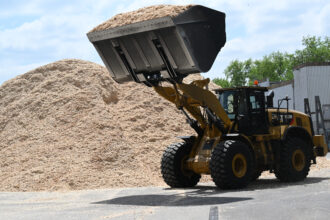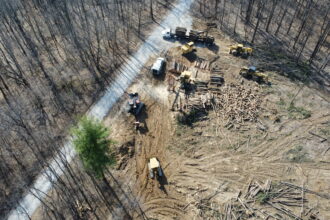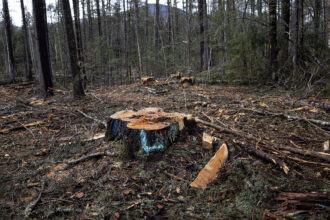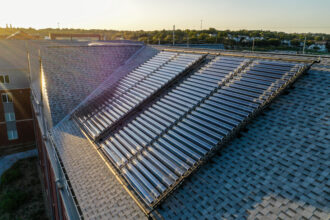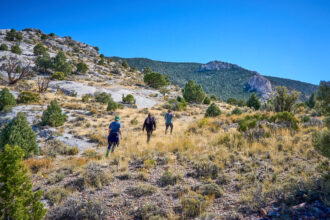TUSKEGEE, Ala.—On a fall walk through Tuskegee National Forest, ecologist John Kush kept his eyes on the ground, looking for sprouts of hope.
“It’s not too bad,” he said, cautiously. “The overstory is longleaf. But it’s the understory that tells the picture.”
A retired Auburn University research fellow, Kush has spent much of his life studying Pinus palustris—the longleaf pine. The state tree of Alabama, it once reigned throughout the southeastern United States, but was all but given up for dead not long ago. Beginning with European settlement, and accelerating after the Civil War, logging and resin extraction drove the sturdy, long-needled species to near-extinction. Less than 3 percent of its original 92 million acre range remained by the 1990s.
Kush worked early in his career at the Escambia National Experimental Forest, in Brewton, Alabama, near the Florida state line, which produced key research on bringing back the tree that anchored one of the most extensive and biodiverse forest ecosystems in North America.
Now, in what has been called one of the most ambitious landscape restoration projects in the world, Tuskegee National Forest is one of thousands of sites where forest managers have been trying to put such research into practice. As he walks the forest, Kush sees both promising signs—a cluster of baby longleaf pine seedlings—and troubling ones: patches of small hickory trees and hawthorn shrubs, woody growth that can crowd out the longleaf with shade and thick groundcover.

Longleaf restoration is a struggle against such competition. It requires careful monitoring, probably herbicides, possibly the harvesting of nearby trees, and certainly fire—blazes repeated as frequently as every two years and carefully timed for both the weather and the condition of the forest.
Advocates believe the effort is worth it—not just for the trees, but for society. They see restoration as an important nature-based solution for storing carbon and making the South more resilient to climate change, in tune with President Joe Biden’s view of forests’ role in achieving U.S. goals under the Paris climate accord. His aim: better management of domestic forests for climate resilience.
But the restoration effort also can generate carbon emissions, due to both burning and the cutting down of older trees to make way for young longleaf—clashing with Biden’s stated objective of protecting mature forests as carbon sinks. It will take time for new longleaf forests to pick up the slack as carbon storehouses, years during which pressure from development and competing trees is a constant threat. The timing of prescribed burns is also becoming more difficult due to hotter summers and unpredictable weather. Meanwhile, some of the logging for longleaf restoration provides feedstock for biomass energy, which even its biggest supporters in Europe have been rethinking due to concerns about its sustainability.
The coalition steering the project, America’s Longleaf Restoration Initiative, or ALRI, includes three federal agencies, nine states, numerous nonprofit groups and an array of corporations, some more commonly associated with logging than restoration. Among them are International Paper, Weyerhaeuser, and the biggest companies in the wood pellet bioenergy industry, Enviva and Drax, which are entangled in controversies over the climate costs and benefits of their practices. A conservative estimate of the money spent on longleaf restoration by ALRI participants since 2010 is at least $700 million.
But the group recently acknowledged it is not on track to meet the target it set in 2009 to more than double the extent of longleaf forest from 3.4 million to 8 million acres by 2025. Instead, longleaf acreage has increased about 30 percent, to 5.2 million acres, and at the current growth rate, would reach 5.5 million acres by 2025. So when ALRI released a new conservation plan in November to guide its activities through 2040, the group recommitted to the 8 million acre target, but doubled the time it is allowing to meet the goal. ALRI hopes to accelerate the pace and improve the quality of restoration.
“We can plant lots of trees—we know that—but it’s the follow-up management that has to be put into place to really take rows of planted trees to a functioning forest,” said Carol Denhof, president of the Longleaf Alliance, who’s chairing the restoration partnership this year.
On private land, which holds 87 percent of southeastern U.S. forests, lack of know-how or costs can hinder the intensive management and prescribed fire that longleaf needs. The vast majority of restoration work takes place on the 13 percent of the forests on public land. But other imperatives can take priority there. On National Forests, prescribed burns are sometimes deferred for as long as 10 years to allow for timber sales, said Earlene Jackson, the Forest Service’s Southern Region silviculturist (forest management specialist). That’s the upper limit of the recommended interval between burns for maintaining a healthy longleaf forest.
Meanwhile, the inescapable backdrop is global warming, which increases drought and other conditions that force forest managers to curtail burns. The South’s longleaf restoration effort embodies all of the challenges of implementing nature-based solutions to the world’s carbon overload on a landscape that is already being reshaped by climate change. The things that longleaf pine need most to survive—time and space—are in vanishingly short supply.
Kush summed it up in a paper for one of the many southern forestry conferences focused on longleaf: “It is a long-rotation species trying to make it in a very short-sighted world.”
“Airy” Forests, Destined to Disappear
The main walking path bisecting Tuskegee National Forest is Bartram Trail, named after the 18th Century naturalist, William Bartram, whose chronicles of journeys here and throughout the southeast are the only remaining picture of what the longleaf forest looked like in his time.
In a 1791 book best known simply as, Travels, a work that inspired the poets Wordsworth and Coleridge, Bartram described “expansive airy pine forests” where the earth was covered with grass, “interspersed with an infinite variety of herbaceous plants, and embellished with extensive savannas, always green, sparkling with ponds of water…”
He was capturing longleaf’s uniqueness—not just the starburst clusters of needles as long as 18 inches—but what grows in the wide spaces between the trees. Mixed grasses, wildflowers and unusual plants (like the carnivorous Venus flytrap and white-topped pitcher plant) made the longleaf forest a biodiversity hot spot. Its unique inhabitants included the red-cockaded woodpecker, with its uncanny ability to select old pines with decaying heartwood for nesting; the eastern indigo snake, at more than 9 feet, North America’s longest native snake; and the gopher tortoise, which excavates extensive tunnels used as refuge by more than 300 species.
The woodpecker and snake, along with about 30 other species, are federally listed as endangered, while the tortoise and many more are considered threatened by the demise of the longleaf pine.
Even as Bartram was writing his longleaf ode, North Carolina was becoming the “Tarheel” State by cutting longleaf and tapping its resin for the tar, pitch and turpentine used for waterproofing wooden ships.
Railroad construction, accelerating after the Civil War, put the Deep South longleaf forest within reach—not only for naval stores but for lumber. Sturdy, straight-grained longleaf wood became so globally prized that Prince Albert and Queen Victoria used it in Scotland’s Balmoral Castle.
A rush on the Southern forest ensued, and by the end of the 1800s, America’s biggest lumber export was southern yellow pine—primarily, longleaf—with 150 million board feet shipped out of Mobile annually, a nearly seven-fold increase in less than two decades, wrote historian Lawrence Early in his 2004 book, “Looking for Longleaf.” In 1897, the botanist Charles Mohr warned: “The exhaustion of the resources of these forests within the near future is inevitable.”
Writing for the U.S. Department of Agriculture’s Division of Forestry—predecessor to the U.S. Forest Service—he noted that longleaf did not tolerate shade, and its small seedlings, which resembled clumps of grass, were quickly crowded out by faster-growing trees.
Mohr didn’t realize that this “grass stage,” which could last for years, was key to the longleaf surviving—and thriving—amid frequent, low-intensity ground fires. A thick cluster of needles protects the bud of the small seedling while growth occurs apace underground—making the young longleaf resilient to the fires that shaped the American South, which has more lighting per acre than most of the world. Native Americans living alongside longleaf for millennia set fires or let them burn to provide clearings, and longleaf thrived.
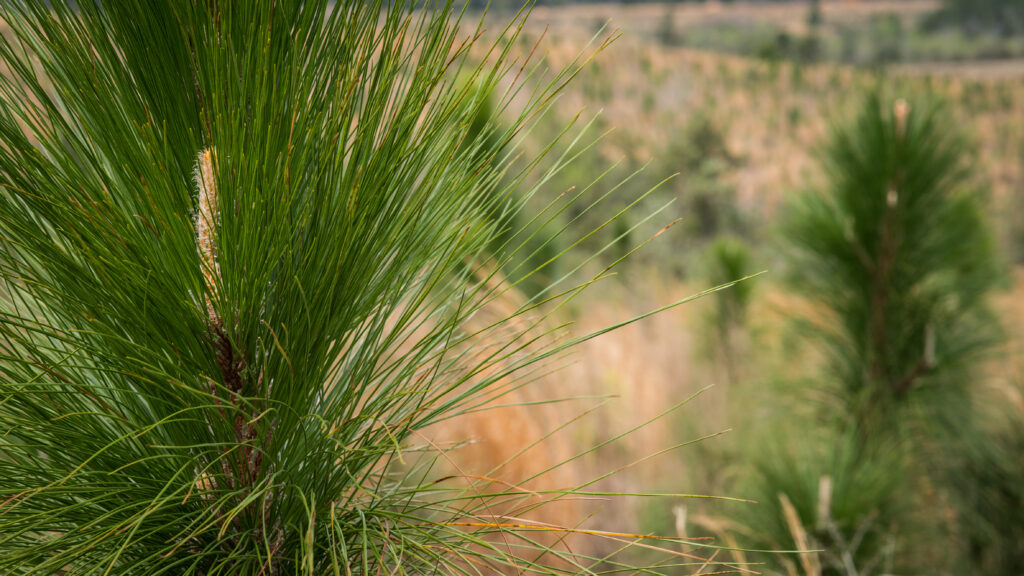
But as settlers built amid forests and suppressed fire, they hastened longleaf’s demise.
In the early 1900s, some of the research confirming fire’s role in longleaf regeneration was done on the lands of Kaul Lumber Company, a major Alabama timber firm. But in the following decades, extraction depleted the Kaul family’s timberlands and during the Great Depression, the family sold them off, in some cases to the federal government, which eventually made them part of Talladega National Forest.
In 1949, then-Alabama state Rep. Hugh Kaul, scion of the lumber family, introduced the bill making the “Southern pine tree” the state tree. In 1997, the Legislature would specify that this meant the longleaf pine. The designation was in some sense a posthumous honor. By the time Kaul served in the state House, Alabama’s vast longleaf pine forest was gone.
Marketable Substitutes, With Environmental Costs
And yet, Alabama is currently among the most densely wooded states in the country, with forest covering 71 percent of its land. Because virtually all of that forest—23 million acres—is open to logging, Alabama has more timberland (forest with marketable trees) than any other state except Oregon and neighboring Georgia.
Loblolly and slash pines, once only a small part of the Southern landscape, were planted for decades to replace longleaf. They were easy to grow and fast-maturing, although not as robust as longleaf, which can live for 200 years, with specimens as old as 450 years old recorded.
The new trees didn’t need to last long. Harvested for fiber in as few as 20 years, loblolly and slash pine fueled the rise of the pulp and paper industry in the South. Today they are feedstocks for the fast-growing wood pellet industry, which fuels electricity plants, mostly in Europe, where, despite controversy, there are big incentives for biomass as a climate solution.
Kush did his graduate work at Auburn in the late 1980s at a lab alongside plantation pines.
“That really, really sucked,” he recalled.
“Forestry there was just all about growing trees really fast for pulp to turn to newsprint,” he said. “And the understory was just filled with briars, vines, ticks, chiggers, all sorts of stuff. It was just no fun to be out there. And there was no biodiversity whatsoever.”
Without long-lived pines and their fire-dependent understory, there was no support for the insects, birds and other species that once thrived in the ecosystem. For example, red-cockaded woodpeckers seek out trees more than 90 years old—far older than the anticipated lifespan of a loblolly in modern timberlands.
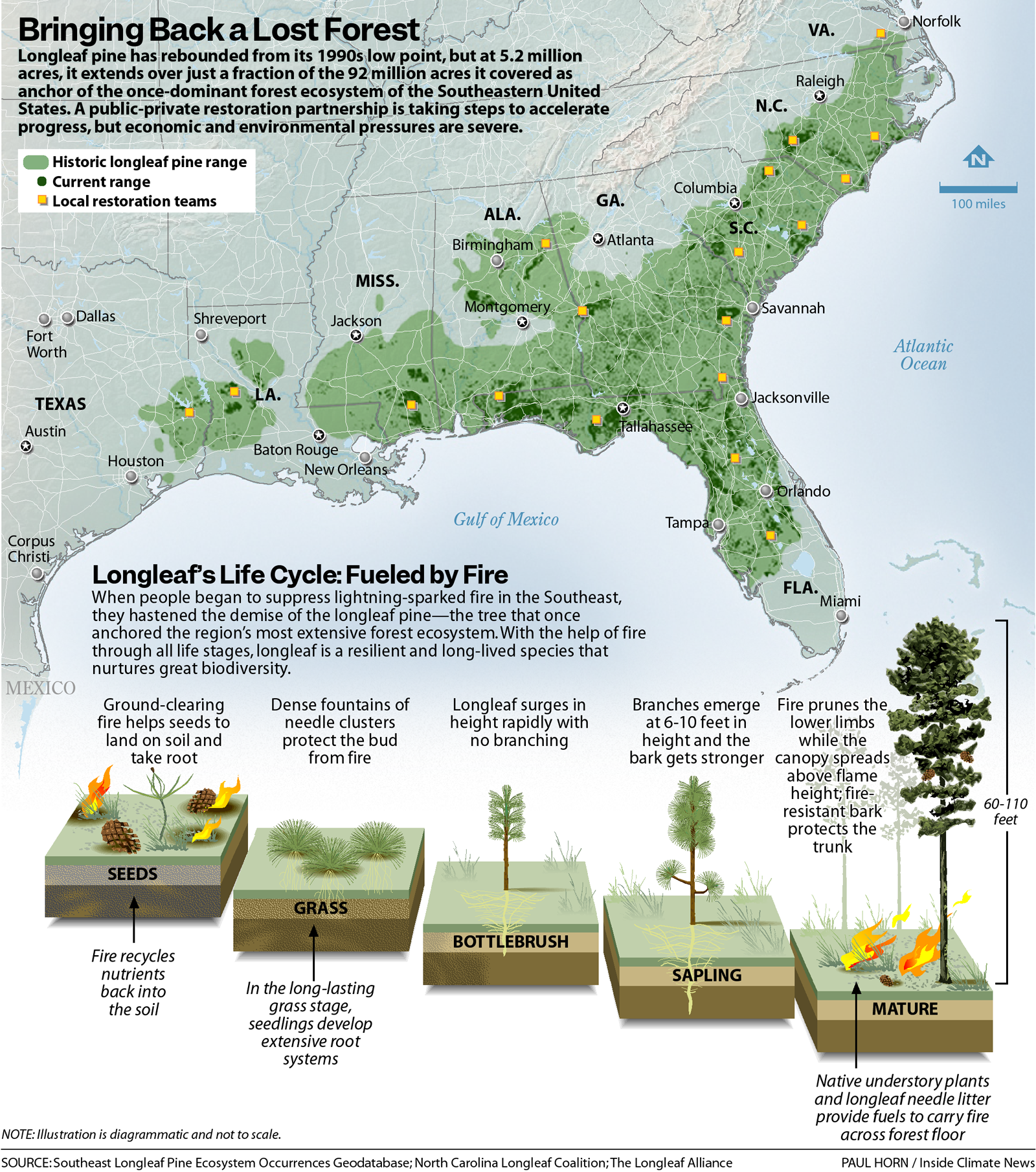
The woodpecker landed on one of the first U.S. endangered species lists, in 1970, and its numbers continued to fall as its habitat shrunk further in the ensuing decades. In 1995, the Interior Department’s first comprehensive report on the nation’s degraded ecosystems listed the longleaf forest among the most critically endangered in the country.
“Humans can plant trees but cannot yet re-create a forest,” it stated.
But forest scientists were studying how to re-create the longleaf forest.
Forest Service researchers at the 3,000-acre Escambia National Experimental Forest published landmark work in the 1970s on getting longleaf to regenerate. (Instead of clearcutting, they urged a “shelterwood” method that retains a sufficient number of seed-bearing trees.) They also showed how frequent fire clears the understory so longleaf seeds can fall directly on soil, where they need to germinate more rapidly than other trees. That’s one reason Kush, the forest ecologist, watched the ground in Tuskegee National Forest.
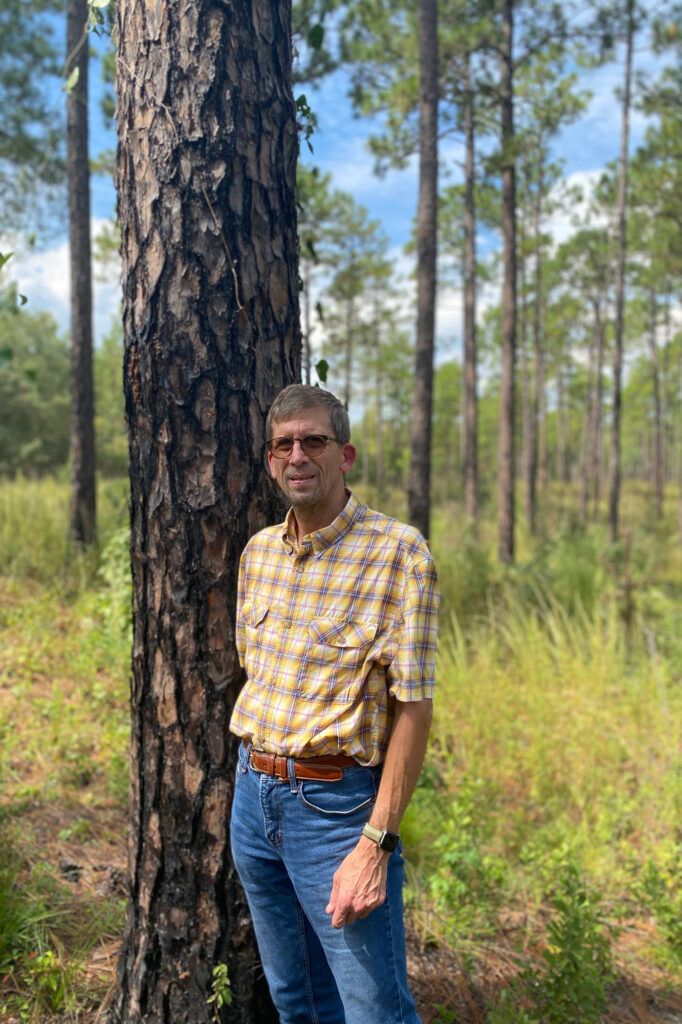
“If you want to try to do regeneration, you’ve got to get this understory cleared up,” he said. “The seed will fall on this stuff (understory vegetation) and it has no chance of surviving.”
As Kush, an Illinois native, was finishing his degree, he worked at Escambia with the Forest Service longleaf pioneers.
“Fire was the big driver,” Kush said. “And when I saw that working, I said, ‘Oh my God, this is what forestry should be all about.’ So now, 40 years later, I’m still in the South, and longleaf pine and fire became my passion.”
In the mid-1990s, two Auburn forestry professors, Rhett Johnson and Dean Gjerstad, felt the same passion for longleaf, but saw little coordination of restoration efforts. They founded the nonprofit Longleaf Alliance to connect those working to bring back longleaf and disseminate the knowledge gained at Escambia and elsewhere.
“It was like we were Johnny Appleseeds,” Johnson said in previous interviews. “We’d scatter like a covey of quail and go to four different states.”
The effort was not about creating what Johnson referred to, in a 2012 book, as “museum pieces.” It was instead a pragmatic idea of longleaf as part of a “working forest”—generating timber and other forest products as well as environmental benefits.
That vision matched a reality: Most of the historic longleaf range was in the hands of private landowners who wanted or needed revenue from their forests. “There aren’t that many landowners that can just do it for longleaf’s sake and because they want to see it grow and become beautiful,” said Denhof, who has served for a dozen years as Longleaf Alliance president.
And even public landowners like the Forest Service, with a mission its founder, Gifford Pinchot, called “foresighted utilization,” are committed to a pragmatic vision of working forests, balancing restoration with other priorities, like timber sales.
A Focus on Private Land, With Public Support
Longleaf Alliance leaders felt the best opportunity to re-establish the species was on private lands, but that could be challenging.
In an Alliance newsletter exchange, one landowner said his young longleaf turned yellow and brown after he sprayed with herbicides to control weeds and competing hardwoods. An Alliance expert said “a well-timed prescribed burn” would have worked better than an herbicide that could kill the longleaf bud. “Embrace the flame and burn next time,” the expert wrote.
But Alliance publications also tell success stories, like that of a cattle farmer in Perry County, Alabama, Roy Barnett, who turned part of his land over to longleaf, with the goal of grazing his herd near and among the pines—a practice known as a silvopasture. In southern Georgia, Herbert Hodges converted part of his 600-acre, 140-year-old family farm to longleaf, making the economics work in part by harvesting pine straw from the forest floor to sell as high-end mulch. The Hodges hosted a longleaf restoration workshop early this year geared to fellow Black landowners.
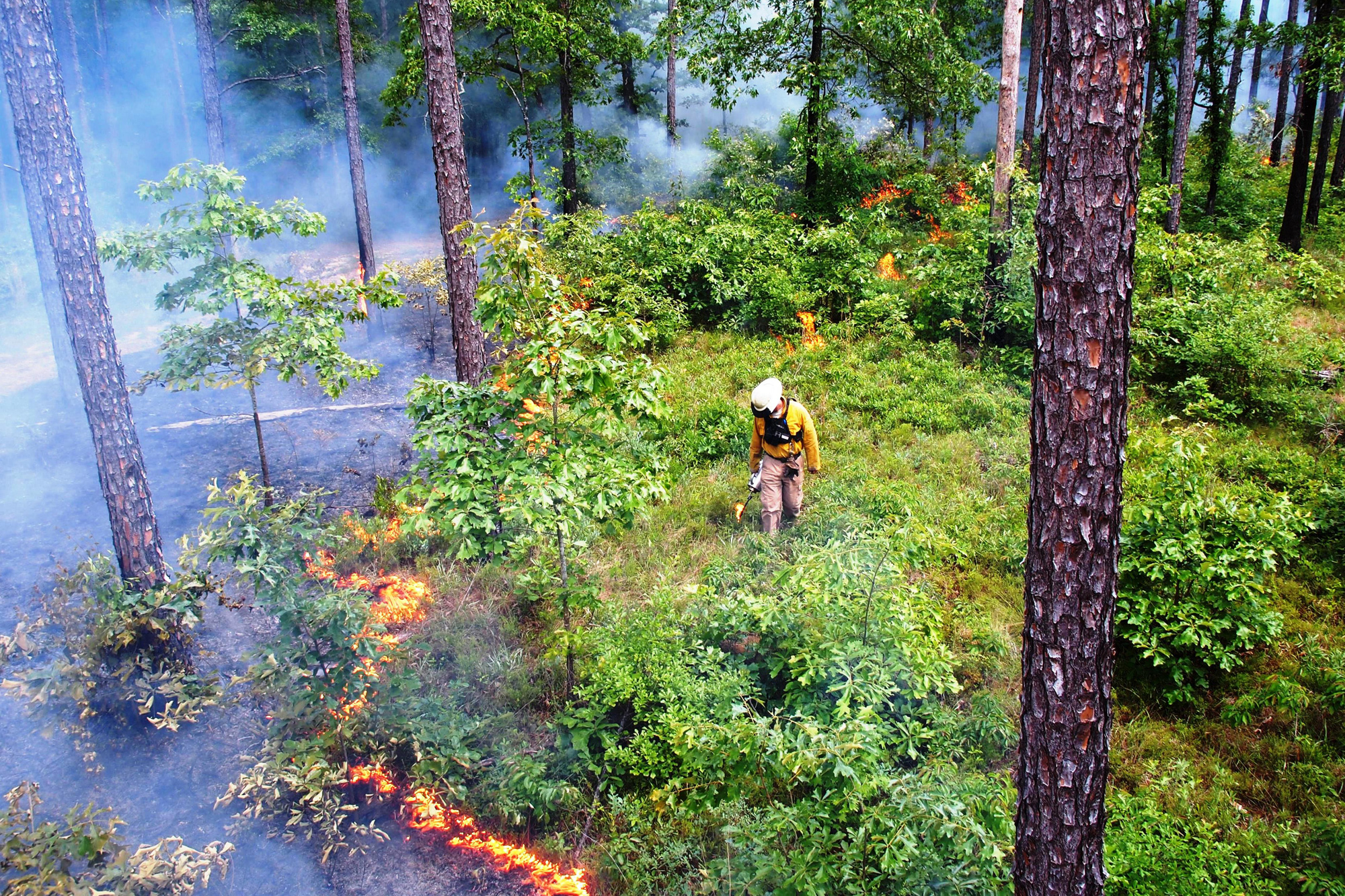
By 2009, 14 years after the Longleaf Alliance was founded, the Forest Service’s periodic national forest census showed the first increase in longleaf acreage in the survey’s 80-year history (and probably the first since European settlement)—from about 3 million acres in 1995 to about 3.4 million acres. Also in 2009, the Longleaf Alliance and its vast array of partners published their first rangewide conservation plan, formally launching America’s Longleaf Restoration Initiative, with the goal of having 8 million acres of longleaf in 15 years.
With 18 local implementation teams throughout the South, the ALRI has spearheaded planting of more than 1.7 million new acres of longleaf, burning over 17.1 million acres and implementing new protections for more than 363,000 acres. Those involve government conservation easements or acquisitions by nonprofits, like The Nature Conservancy’s $2 million purchase this fall of a diverse 600-acre longleaf tract in Bibb County, Alabama.
“Very few [restoration efforts] can match what has been done here,” said Jay Jensen, director of the southern office of the National Fish and Wildlife Foundation, or NFWF, a nonprofit that has raised and administered $75 million in grants, drawing $83.7 million in matching contributions.
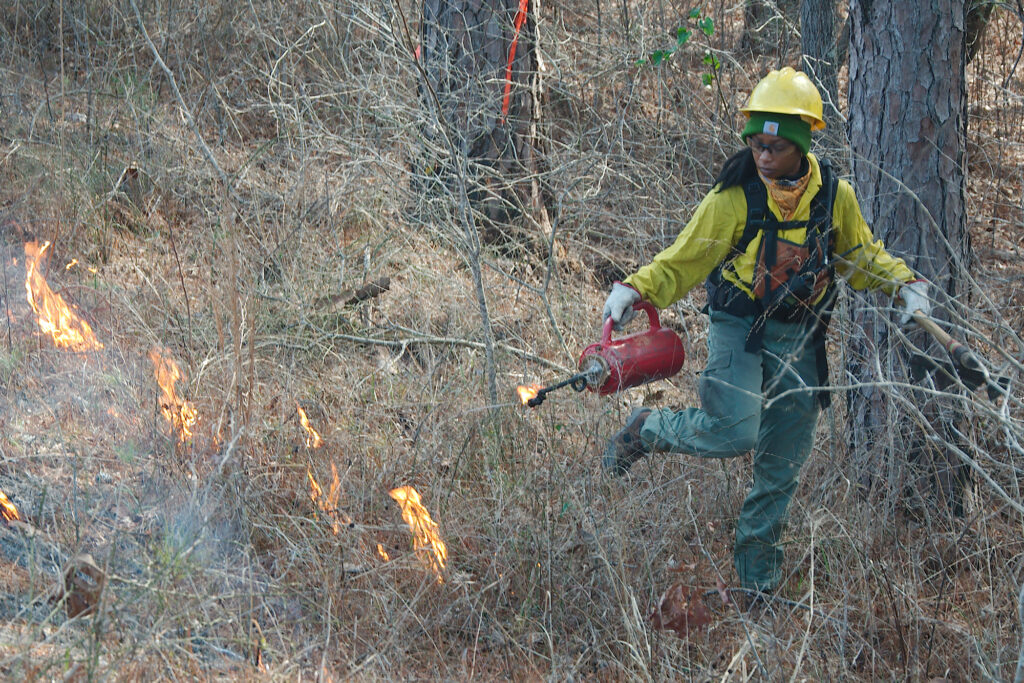
Jensen, who served with the Western Governors’ Association, and then, on President Barack Obama’s White House environmental team, said it is far different working on a private lands-dominated landscape than in the West, where most forest is federally owned.
“It is really special to be able to knit together thousands of private landowners—in all their multi-varied objectives and purposes—to a common vision that people want to be part of,” he said.
But they couldn’t do it without government help.
In 2010, three federal agencies—the departments of Agriculture, Defense and Interior—signed a memorandum of understanding committing to the conservation plan. Government spending since then has been spread out through an array of farm, forest, land and wildlife conservation programs.
The Pentagon—a seemingly unlikely partner to the land agencies—oversees some of the largest contiguous longleaf tracts at facilities like Fort Moore in Georgia and Eglin Air Force Base in Florida. The military’s sheer presence kept significant tracts of land protected from real estate development, and it grew to value the forest as a buffer with ideal open savannahs for training maneuvers. And fires set off by live ammunition were not a problem for longleaf.
But the Agriculture Department has had the biggest role in restoration. USDA environmental incentives have provided crucial funding for private landowners like Barnett and Hodges, who forgo faster returns from crops or loblolly plantations to grow longleaf. The USDA’s Natural Resources Conservation Service reports that since 2010, it has supported some 10,600 landowners growing longleaf on nearly 1 million acres with $198.2 million. In 2022, Alabama was the leading state in land area enrolled, accounting for nearly 30 percent of NRCS’s 111,696 longleaf acres.
National Forests cover almost 6 million acres in the historic longleaf range—making the USDA Forest Service the initiative’s largest single landholder. National Forests held just 5 percent of total forest in the Southeast, but 24 percent of existing longleaf when the rangewide conservation initiative began in 2009. As restoration has spread, private landowners have increased their share, but National Forests still play an outsized role. Alabama’s four National Forests, accounting for just 3 percent of the state’s forested land, hold 18 percent of its 908,000 acres of longleaf, a 2021 Forest Service status report showed.
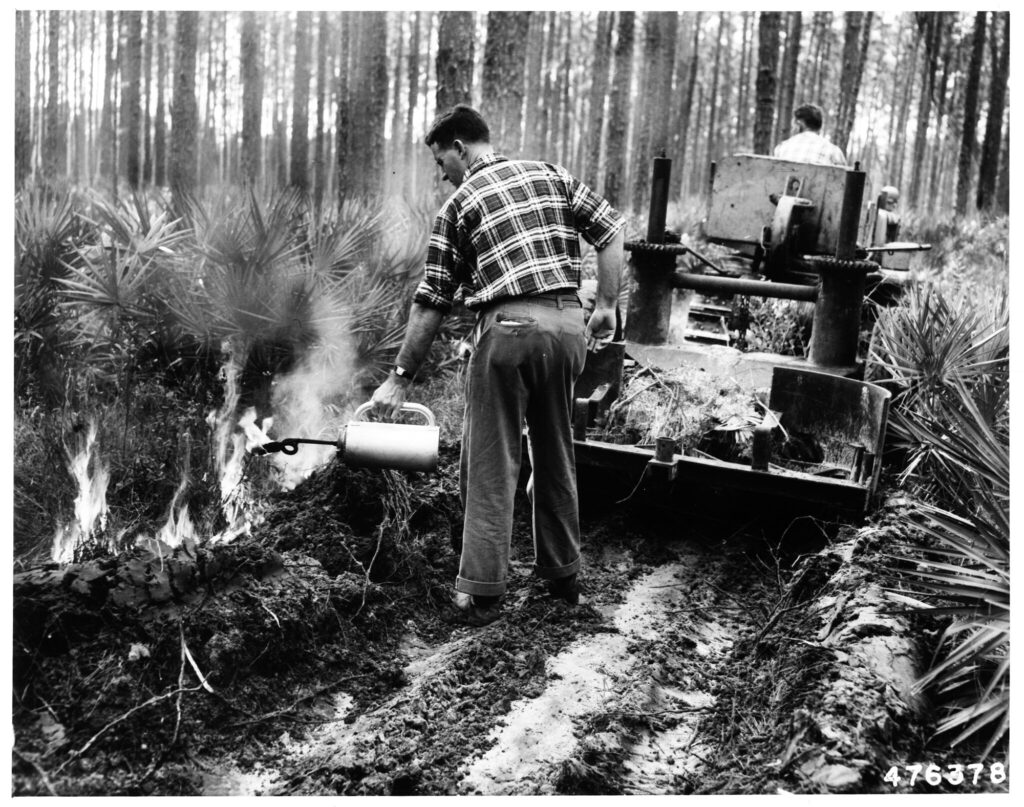
Jackson, the Forest Service’s regional silviculturist, said the agency has spent $500,000 to $1 million annually on longleaf, not including spending at individual National Forests. Three-quarters of the prescribed burning that the Forest Service does nationwide is in the Southeast—about 1.3 million acres annually—and ALRI’s annual reports indicate about 40 percent of that is for longleaf restoration.
The Forest Service in 2017 announced a “Million-Acre Challenge” to put that much additional longleaf pine-dominated acreage back in the National Forests. Since then, according to ALRI’s accomplishment reports, there have been 33,662 new acres of longleaf planted on National Forests.
But Jackson says the agency has fulfilled 88 percent of the goal, with 880,000 new acres “on the path toward longleaf restoration.”
That measure counts any acres with management activities helping longleaf dominate a stand, including thinning or even clearcutting loblolly and slash pines. In Alabama National Forests, there are currently at least 10,000 acres of such longleaf restoration activities planned—half in Talladega National Forest (including 500 acres of clearcutting) in Cleburne County, and half in Bankhead National Forest in Winston County.
With about 70 percent of the Talladega project forest older than 61 years, the longleaf efforts are in addition to more than 20 logging projects targeting mature trees now planned or underway in National Forests around the country, according to the Climate Forests Project. That’s in seeming conflict with Biden’s 2022 executive order to strengthen protection for mature and old growth forests because of their importance in combating climate change. The administration has stopped short of the blanket protection some environmentalists have sought. Instead of treating National Forests as a protected carbon reserve, the Biden administration has made logging off limits at certain sites—like in the Tongass temperate rain forest in Alaska—while pledging to issue rules to enhance “climate resilience” for other public forest nationwide.
The Forest Service views logging loblolly to make way for longleaf as such a resilience effort. Longleaf pines are more resistant than loblolly to beetles and disease, withstand hurricanes better and are remarkably drought tolerant.
“We are trying to manage the land for a healthier, more resilient landscape,” Jackson said. “That means restoring key tree species like the longleaf pine, and we achieve these goals by removing loblolly off sandy soils,” extending throughout the South’s Coastal Plain, including the southern two-thirds of Alabama.
But the Forest Service’s harvesting also can hinder longleaf restoration. For example, the agency can’t do a prescribed burn near where loggers are working. Also, if the Forest Service has a timber stand marked for sale and it doesn’t draw immediate buyers, the agency will delay nearby burning so the trees it is marketing aren’t scorched.
“Timber markets and operational accessibility have acted as obstacles to accelerating the pace and scale of restoration,” Jackson said. “Under certain circumstances, the fire interval may extend up to 10 years to accommodate timber sales, for example, when contracting lasts longer than usual.”
And in the future, longleaf trees themselves are not off the chopping block in a Forest Service with a legal mandate “to produce a sustained yield of products and services.”
“Our agency’s mission is to sustain a healthy diversity and productivity of the nation’s forests and grasslands to meet the needs of present and future generations,” Jackson said. “This means harvesting timber, including longleaf, in areas where it makes sense.
“Ecosystems are not static in the way ‘preservation’ can sometimes imply,” she added.
That view is in line with the wider longleaf preservation effort envisioned by Auburn professors Johnson and Gjerstad, who always stressed the economic value of the species—its potential yield of stronger and more valuable timber than loblolly—as well as its environmental benefits.
The philosophy that logging goes hand-in-hand with restoration helps explain why forest products companies are some of the biggest longleaf restoration participants.
Corporate Investment Pays Dividends in Reputation and Fiber
Longleaf restoration has attracted an array of corporate supporters—not just timber companies—who do business in the South and are seeking to show a commitment to environmental protection.
For example, utility giant Southern Company, with a fleet that includes an Alabama coal plant that is the nation’s worst greenhouse gas polluter, has been investing in longleaf pine restoration since 2004 through the National Fish and Wildlife Foundation. But for forest products companies, engaging in longleaf restoration does more than burnish environmental reputations. It is a potential source of raw material.
Both Enviva and Drax, the biggest names in the wood pellet business, with massive new Alabama facilities and plans for further expansion, are members of the Longleaf Alliance.
Jay Hayek, Drax’s forest nature and conservation manager, said via email that Drax has also made a “significant contribution” to the Alabama Wildlife Federation’s Land Stewardship Assistance Partnership, which advises private landowners on longleaf restoration.
Loblolly and slash pines that landowners cut down to make way for longleaf can provide pulpwood feedstock, mixed with logging residues and sawmill waste, for wood pellets. “Our biomass removals will serve as a critical step in the longleaf restoration process,” Enviva’s web site states. (Enviva, recently experiencing financial difficulties, did not respond to messages seeking comment for this story.)
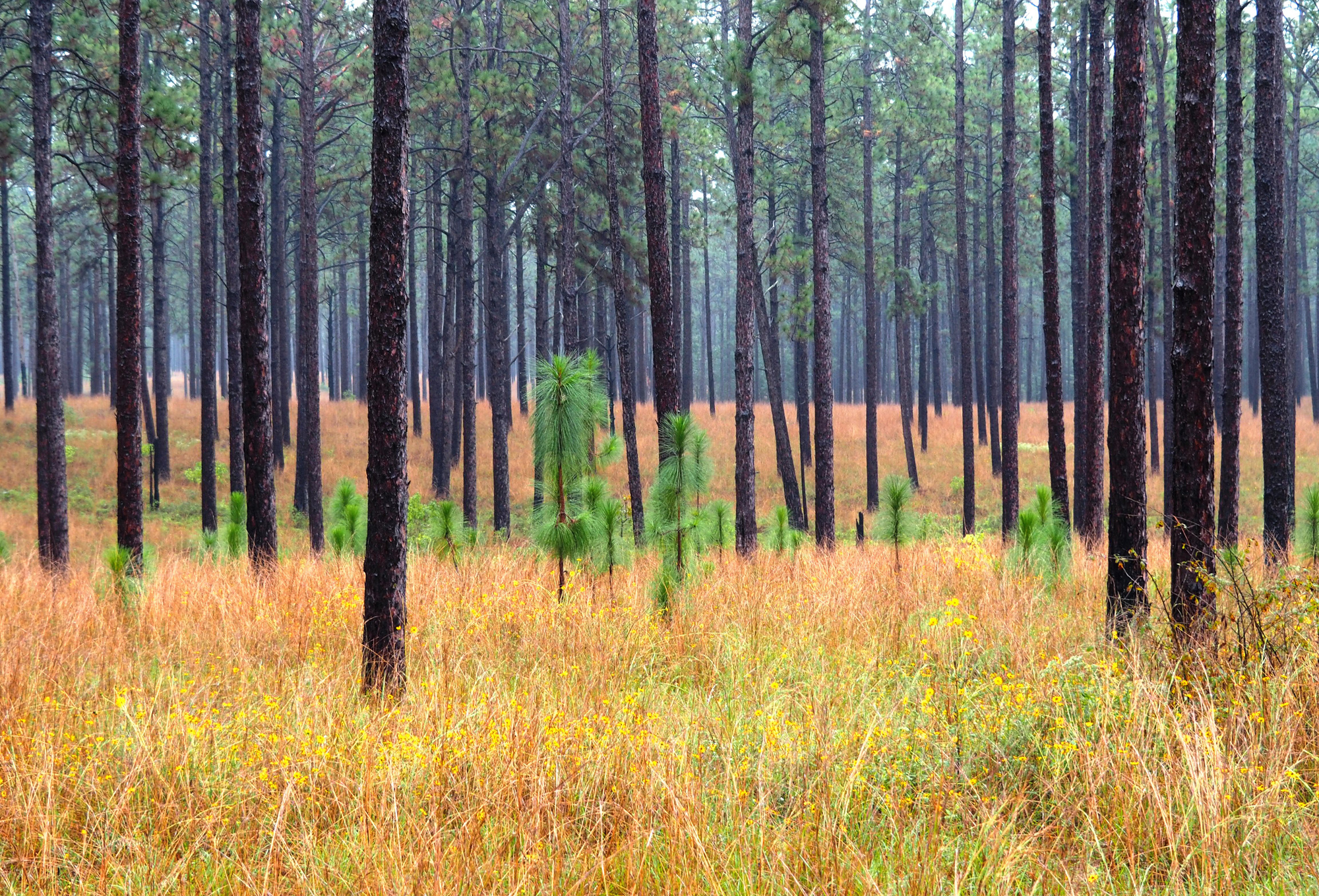
Most wood pellet fuel is shipped to energy plants in the European Union and United Kingdom, which supercharged the industry when they adopted climate policies incentivizing use of “woody biomass” as a renewable alternative to coal for generating electricity. But debate has raged over the practice’s climate impact. And this year, both the UK and the EU—while rejecting harsher restrictions—revised their policies to stress government incentives should go to biomass produced sustainably.
Wood pellet companies say harvests for longleaf restoration fit the bill. “As a global leader in sustainable biomass, Drax is fully committed to the restoration of longleaf pine systems and the abundance of ecosystem services these forests provide,” said Hayak. “Our market for low-value material could be leveraged to assist with establishment, maintenance, and rehabilitation of these longleaf savanna ecosystems.”
But longleaf restoration also assists the wood pellet business, industry critics point out.
“Large companies sponsor these efforts because eventually, it will result in fiber,” said Sam Davis, conservation scientist with the North Carolina-based Dogwood Alliance. “Many landowners are promised ‘working forests,’ just on a slightly longer timescale because longleaf doesn’t grow as fast as loblolly.
“They get a double payoff,” Davis said in an email, ”clearing at the beginning of a project, and then the end-goal of harvesting the trees for fiber after they reach maturity. Plus subsidies for ‘conservation’ and ‘restoration’ in the interim.”
Wood pellets for biomass fuel are not typically made from longleaf pine—a tree which, if harvested, can garner a far greater price as timber for use in durable wood products and structures.
But Hayek sees putting more longleaf on the landscape as a goal in sync with Drax’s business of harvesting lesser value wood for pellet mills.
“The development and maintenance of longleaf savanna ecosystems requires controlling stand density and keeping the forest in an open condition,” Hayek said. “Without the benefit of our historic fire regime, management is necessary to control competing trees and shrubs that would reduce the ecological value of the habitat.”
In forestry, “management” includes cutting trees.
A Natural Climate Solution, But a Complex Carbon Picture
Longleaf pine restoration could be a powerful natural solution for reducing atmospheric carbon—eventually.
Longleaf stores more carbon than other pine species, mainly underground in soil and roots. As the longest living of the southern pines, longleaf could be sucking up carbon from the atmosphere for hundreds of years if preserved. And if you’re counting carbon stored in harvested forest products—as both the industry and the U.S. government do—there is little question that long-lived wood beams made from longleaf store more carbon than cardboard boxes or wood pellet fuel made from loblolly.
But in the short term, restoring longleaf requires a lot of forest clearing, which releases a lot of stored carbon.
“If existing trees are harvested to make way for longleaf restoration, there will be a ‘carbon debt’ for a while until the new trees are well established,” said Richard Birdsey, a senior scientist at the Woodwell Climate Research Center in Falmouth, Massachusetts. “I’m not sure how long that would be, but probably a few decades depending on how much biomass was in the forests that were harvested,” said Birdsey, who produced forest carbon studies during 40 years with the Forest Service.
The fires that longleaf forests need also generate carbon emissions.
“There’s a balancing act between the emissions that come from low-intensity prescribed burns, and the growth that comes from those trees,” said Jensen, of the NFWF.
Scientists have come up with conflicting results when trying to measure that balance. One 2015 study at Fort Moore on the Georgia-Alabama border concluded that sites thinned and burned to increase longleaf dominance would store 22 percent less carbon than sites where no logging or burning took place. But a follow-up study came to the opposite conclusion: longleaf restoration would store 20 percent more carbon than unmanaged forests, because prescribed burns would reduce the risk of far more carbon-intensive wildfires.
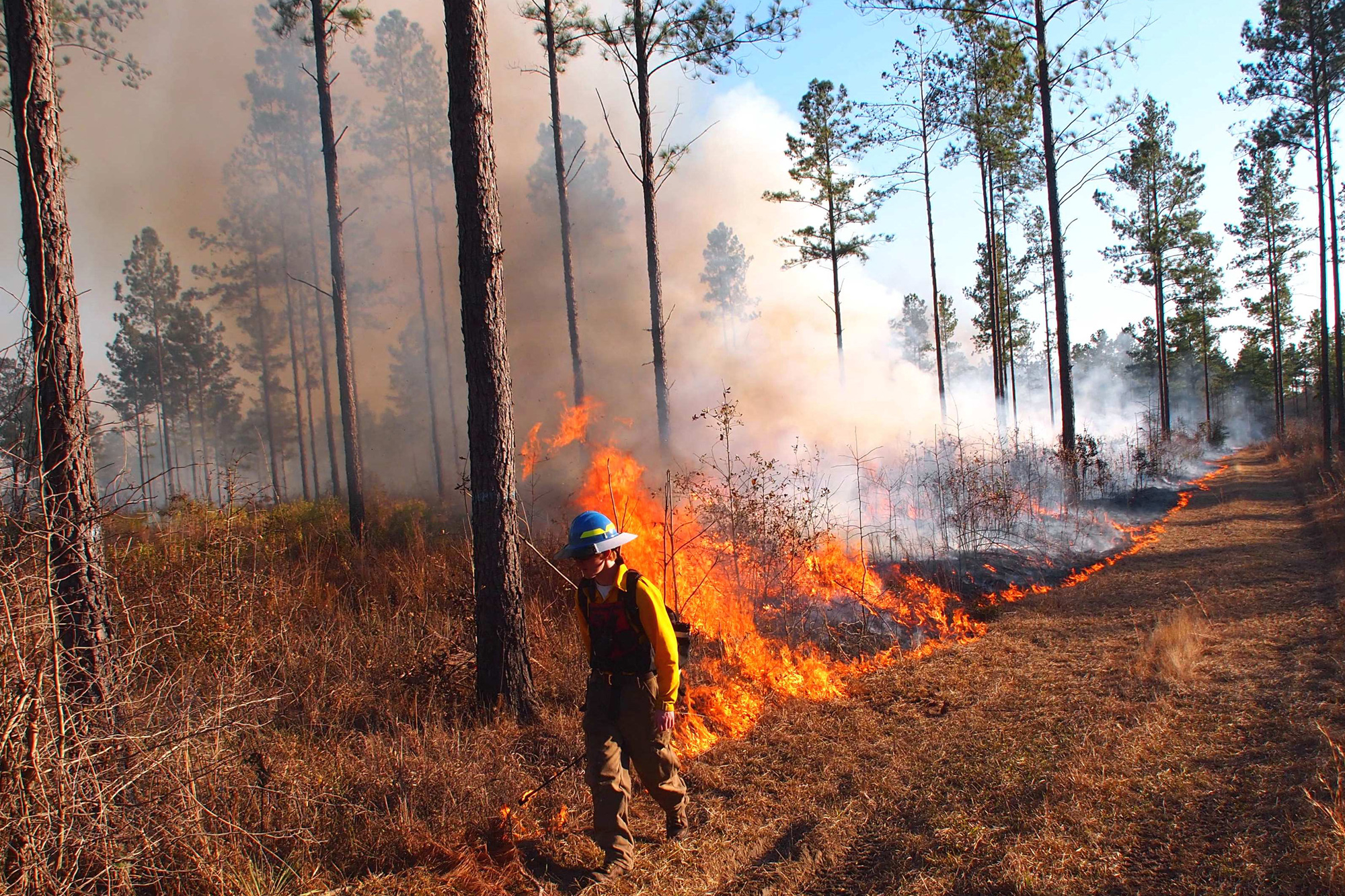
“There’s a huge bit of science going on right now, really trying to understand what that carbon balance looks like,” said Jensen. “There are places where, when you plant the trees and manage it right, you get a ton of carbon, but I don’t want to paint a picture like longleaf is an easy carbon-positive story. It’s complicated.”
Such complexities abound in the realm of nature-based solutions for climate change. That’s why the Intergovernmental Panel on Climate Change, in a 2021 joint report with a U.N. panel on biodiversity, urged tackling the climate and biodiversity crises together. The report noted the potential for many trade-offs in land restoration efforts, and stressed that nature-based climate solutions are no substitute for ambitious, rapid cuts in fossil fuel emissions.
For now, the money pouring into climate action is increasing funding for longleaf restoration. Jackson, of the Forest Service, said longleaf is benefiting from additional money that Congress had made available for “hazardous fuels management,” or wildfire prevention. The USDA’s Natural Resources Conservation Service devoted about $11 million to longleaf restoration on private land 10 years ago, but nearly doubled that to $21 million by 2022.
As for private efforts, the NFWF announced its largest ever slate of longleaf restoration grants this year, doubling its prior year’s record spending, thanks in part to a major contribution from the climate-focused Bezos Earth Fund. Established by Amazon founder Jeff Bezos in 2020 as the largest philanthropic commitment ever to fight climate change and protect nature, it sees longleaf as emblematic of its mission.
“We’re building our restoration portfolio to really focus on the handful of landscapes around the world where locally led restoration can have a globally significant impact,” said Emily Averna, the Bezos fund program officer for land restoration, in a NFWF video. “We need to be thinking about the systems change that needs to happen around these really great locally led efforts so that they can grow, replicate, and scale rapidly.”
Reviving a Species in a Warming World
But there’s an unspoken race in the South for what will scale more rapidly: restored longleaf forest or the other changes wrought by humanity on the ground and in the atmosphere.
ALRI acknowledges this in its new rangewide plan, which sets a goal of adding 2.8 million longleaf acres by 2040—essentially, recommitting to its original plan of bringing longleaf extent to 8 million acres, but 15 years beyond its original target of 2025. Even with the time extension, it would mean accelerating the pace of longleaf establishment by about 20 percent.
“The partnership made the decision to maintain the 8 million acre goal since we still have much work ahead to reach, and hopefully go beyond, that goal,” said Denhof, of the Longleaf Alliance. She said the partnership aims to surpass that target.
At 8 million acres, longleaf would occupy 9 percent of its historic range.
This story is funded by readers like you.
Our nonprofit newsroom provides award-winning climate coverage free of charge and advertising. We rely on donations from readers like you to keep going. Please donate now to support our work.
Donate NowIn the rest of the range, sprawl and growth of the region’s population to 90 million led housing and commercial development to consume 1.7 million football fields-worth of forest between 1985 and 2019. That’s more forest loss than in any other region of the country, according to the new National Climate Assessment released in November by the Biden administration. The report said urbanized land is projected to increase 9 percent more throughout the region by 2060.
The longleaf partners feel the pressure. “You know, we’ve planted a lot of longleaf since this effort began,” said Denhof. “But we’ve also been losing a lot of longleaf.”
Other trees and brush are also crowding out longleaf.
On his recent walk through Tuskegee National Forest, Kush pointed out a longleaf stand that was half loblolly, and predicted the faster-growing tree “will be the ultimate winner.”
“If you take fire out of a system, the understory will fill up with loblolly pine,” he said.
The Forest Service has approved prescribed burning of the Tuskegee stands over the next five years, and indeed, Kush saw signs it was burned recently. But fire only “top-killed,” or scorched the crowns of hawthorn and hickory in the understory, and the woody competitors came back.
“Poison oak is pretty rampant,” Kush added. “You wouldn’t have poison oak in a frequently burned system that saw fire in the growing season.”
Kush said many obstacles can get in the way of effective burns, especially in a forest enmeshed in civilization like Tuskegee, with Interstate 85 crossing through its north end to connect Atlanta and Montgomery. “There’s just so many roads in the South that it’s tough for you to get those hundred-thousand-acre fires you can have out West on all that public land,” he said.
Also, burning in the spring and summer—the time of year when lightning historically set fires across the southern landscape—is crucial for removing the hardwood competition, said Kush, a co-author of research showing that wintertime burning is not as effective.
But more prescribed burning is shifting to winter, as scientists see climate change substantially reducing the number of summer days in the South when temperatures and other conditions make burning feasible and safe for fire personnel and for surrounding communities.
In a recent survey, 38 percent of longleaf forest managers said they do not burn as often as they should, due to weather, lack of equipment, funding or personnel.
Tuskegee National Forest, in a sense, is a testament to restoration with limited resources in harsh conditions. At just over 11,000 acres it is the smallest National Forest in the country, carved in 1959 out of what the Forest Service says was “one of the most abused, eroded wastelands in Alabama.” Longleaf had been leveled for farming on what turned out to be unsuitable soil. Loblolly was then planted in hope of stopping erosion and generating future revenue. In recent years, the Forest Service has harvested many of those pines while trying to undo past mistakes and encourage a return of longleaf.
And Kush sees some signs it is working. Beyond the woody brush, he spots a group of baby longleaf seedlings, balls of pine needles poking out from tiny sticks in the ground. They weren’t planted but naturally regenerated from seeds that fell from the overstory.
“That’s encouraging,” Kush said.
Back at his truck, Kush pulls out a circular tablet. It is a two-foot wide cross-section from a longleaf pine that likely took root around 1685, and lived more than 300 years before it was cut down in 1996 near Flomaton, Alabama. The tree rings reveal an astonishing history—the tree grew just 5 inches in diameter in its first 140 years. Competition was almost certainly intense. Then, when the tree was more than 200 years old, the stand must have opened up. The longleaf surged, reaching 50 feet in height.
“Most trees would’ve died somewhere in this period of slow growth,” Kush said, marveling at its ability to hang on. “You’re not going to see that with any other species in this country.”
That resilience may well aid the grassy longleaf sprouts on the Tuskegee forest floor. And they will need all the help they can get. They are growing in a world that wouldn’t be recognizable to the tree that bore the cross-cut in Kush’s hands—a warmer world, more crowded, with economic pressures far greater than the ones that killed their forebears.






